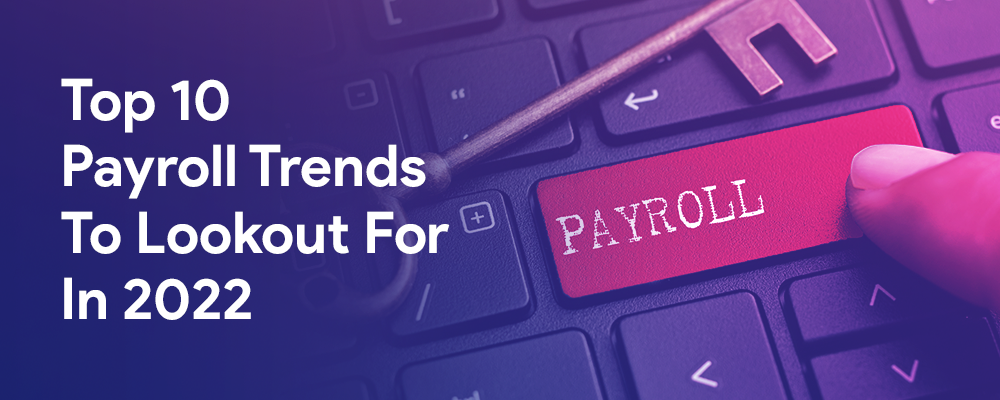Featured Snippet:
Direct bank interfaces for easy, secure, and quick salary payments, Payments on demand, Significant automation, Individualized employee experience, Workplace adaptability, Design conformity, Data insights, etc are some top payroll trends that you should in look at in 2022.
Payroll is much more than just calculating an employee’s salary. It is critical to lobby for better payroll rules in order to keep employees motivated and engaged with the company.
The remuneration alone does not determine the employee’s involvement in the company; nevertheless, it does suggest the employee’s level of involvement in the organization. As a result, better payroll rules must be advocated in order for employees to feel motivated and involved with the organization.
Given below is a list of the top ten trends that will truly revolutionize payroll management in this post. The list includes anything from a continued emphasis on flexible workforces to a greater emphasis on digitalization:
1. Direct bank interfaces for easy, secure, and quick salary payments
Banks and firm payroll software used to be separate entities. Despite regular exchanges, their areas of activity were radically different. It results in longer turnaround times since the payroll software must collaborate with the bank to conduct salary payments.
With the advancement of technology, banks and payroll systems are collaborating to make the entire process simple, time-saving, and effective for businesses and entrepreneurs. Such interfaces have opened up new avenues for banks to communicate directly with entrepreneurs and MSMEs, which are the best sources of consistent cash flow.
2. Payments on demand
People expect to get paid on time. Technology use has increased across businesses and individuals’ homes, resulting in a tech-savvy culture that will no longer tolerate shoddy or late payments from its employers.
Late payments harm a company’s morale, and with the economy improving and many job markets reviving, it’s critical that HR and payroll teams pay employees on time to avoid dissatisfaction and attrition.
3. Significant automation
It is about time to use significant automation in the payroll department. It is not about bringing greater and more comprehensive system automation, such as automatic tax and salary computation.
It is about automating the smallest manual procedures that your payroll department uses the most time. When we become acclimated to the traditional, old-fashioned method, we rarely consider how long it takes to complete even the most basic chores. With automation, you may free up valuable time in the department and focus on other productive activities. Auto-generated employee compensation reports assist the payroll department in shortening turnaround times and increasing productivity.
4. Individualized employee experience
The major factor in overcoming personalization difficulties is to guarantee that the payroll and human resources departments use technology that can adapt to the devices used by employees. People’s lifestyles have become more reliant on mobile gadgets.
The organization can utilize these technologies to manage important payroll and HR concerns and identify effective real-time solutions. The use of mobile self-services also allows businesses to personalize the employee experience and foster a favorable employee-company relationship.
5. Workplace adaptability
Due to covid-19 outbreak, many employees have had to work from home. Therefore flexible working has become the standard. Allowing employees to pick their own work schedules empowers them to do their best work.
While flexible working isn’t right for every company, it’s safe to say it’s here to stay, with many payroll solution providers opting to provide their employees the opportunity to work flexibly. Being an early user of flexible working could provide your company a competitive advantage over the competition.
6. Design conformity
Every region has its own set of tax regulations and labor restrictions, further complicating the procedure. Several companies have a presence in different states, as do many small enterprises around the country. As a result, firms may find it difficult to comply with local legislation and financial laws.
With the growth of payroll technology, automatic compliance solutions that are data-driven and have access to all of the required information for tracking compliance in various regions of the country have been launched. This allows the company to stay up to date on the newest regulatory changes, maintain compliance, and prevent legal complications.
7. Insightful data insights that help your payroll plan
Payroll is one of the most important functions in most businesses. However, it has a number of problems as well as the potential for development in terms of service delivery schedule. The automated payroll system’s deep data insights can assist you with targeted analyses.
This will assist you in defining Key Performance Indicators for payroll functions and increasing the efficiency of their daily operations. The usage of a dashboard can help to enhance processing timeframes and minimize processing error rates.
8. Enhanced globalization
Following on from the flexible working trend, there is no doubt that businesses will reconsider where they establish roles for their employees. This will create a plethora of chances for businesses that will benefit from employing teams from all over the world.
Having spread staff all across the world can be difficult for the payroll department. Transferring money across borders is difficult, and if your employees aren’t freelancers, you’ll need to be fluent in many nations’ tax laws. All of these responsibilities rest largely on the shoulders of the HR and payroll departments, so make sure you’re comfortable managing teams across time zones.
9. More technological investment
The pandemic has compelled technology-averse businesses to use new digital technologies.
Business owners who were still supporting in-person meetings before Covid-19 have had to adapt to a world of Zoom meetings and Google Docs.
As more businesses seek to improve their efficiency through software, HR and payroll departments will need to modify their processes and practices to accommodate new tools.
Software that will allow them to automate their daily duties and free up their time to work on value-added projects that will have a significant impact on their organization.
10. The application of cloud technologies
Cloud computing has now become an essential component of many enterprises. They aid in the resolution of critical business issues and the efficient management of payroll procedures.
You may combine accounting and HR with the cloud-based payroll system to establish tighter integrations with real-time cooperation.
Newer improvements in payroll technology and the company’s inclusion of higher degrees of employee pleasure ensure that employees not only feel like they are a part of a task force but a vital part of it. As a result, understanding and incorporating fresh payroll patterns become increasingly vital each year.
Read also: 10 Ways Recruitment Automation Will Change The Way of Talent Acquisition










